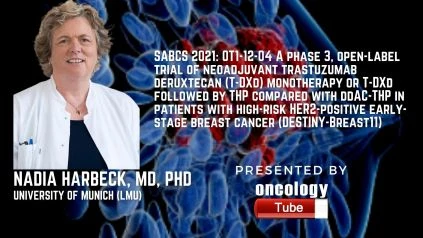Nadia Harbeck, MD, PhD, is head of the Breast Center and holds the chair for Conservative Oncology at the Dept. of OB&GYN, University of Munich (LMU), Germany speaks about the SABCS Abstract – OT1-12-04 A phase 3, open-label trial of neoadjuvant trastuzumab deruxtecan (T-DXd) monotherapy or T-DXd followed by THP compared with ddAC-THP in patients with high-risk HER2-positive early-stage breast cancer (DESTINY-Breast11).
Link to Abstract:
https://www.sabcs.org/Portals/SABCS2016/2021%20SABCS/SABCS21_embargoedAbstracts_111921.pdf?ver=2021-11-19-141323-927
Background:
Trastuzumab + pertuzumab and polychemotherapy are the current standard of care (SOC) for neoadjuvant treatment of human epidermal growth factor receptor 2 (HER2)-positive early-stage breast cancer (EBC). Patients are exposed to short- and long-term toxicity as a result of these multiagent regimens, and many patients, particularly those with locally progressed or aggressive illness, nonetheless incur relapse and/or mortality. T-DXd monotherapy was found to be effective in patients with previously treated HER2-positive unresectable/metastatic breast cancer in the phase 2 DESTINY-Breast01 study, with a confirmed objective response rate of 61.4 percent (complete response, 6.5 percent), median time to response of 1.6 months, and median progression-free survival of 19.4 months (Modi et al. SABCS 2020. Abstract PD3-06). Given the efficacy of T-DXd monotherapy, patients with high-risk HER2-positive EBC may benefit from substituting all or part of their SOC regimens with T-DXd. The effectiveness, safety, and tolerability of T-DXd monotherapy or T-DXd followed by paclitaxel + trastuzumab + pertuzumab (THP) against dose-dense doxorubicin + cyclophosphamide followed by THP (ddAC-THP) in patients with high-risk HER2-positive EBC are compared in this study.
Methods:
DESTINY-Breast11 is a phase 3 global, open-label, multicenter trial that compares the efficacy and safety of T-DXd monotherapy or T-DXd followed by THP as a neoadjuvant treatment to ddAC-THP in patients with high-risk (T stage 3 and/or node positive or inflammatory) HER2-positive EBC. Approximately 624 patients will be randomly assigned to one of three arms (arm A: T-DXd monotherapy every three weeks [q3w] for eight three-week cycles; arm B: T-DXd [q3w for four three-week cycles] followed by THP [paclitaxel every week + trastuzumab + pertuzumab q3w for four three-week cycles]; arm C: ddAC-THP [ddAC every two weeks Three to six weeks after the last cycle of prescribed treatment, patients should have breast or axillary surgery. Patients will be treated according to local clinical guidelines following surgery. Adjuvant HER2-directed therapy for up to one year is suggested for patients who achieve a pathological complete response (pCR). Patients who do not obtain a pCR should be treated with up to 14 cycles of trastuzumab emtansine. Local clinical standards should be followed when administering radiotherapy and endocrine therapy.
Patients will be evaluated for survival and recurrence every three months for the first three years and every six months for years four and five after the final dose of study medication. By central review, the primary outcome is pCR (ypT0/Tis ypN0), which is defined as the absence of invasive carcinoma in the breast and sampled regional lymph nodes. pCR (ypT0 ypN0) by central review (defined as absence of invasive and in situ cancer in the breast and sampled regional lymph nodes), 3-year event-free survival, 3-year invasive disease-free survival, overall survival, patient-reported tolerability, physical functioning, immunogenicity, pharmacokinetics, and safety are all secondary endpoints. Three-year distant metastasis-free survival, objective response rate, rate of breast-conserving surgery, biomarkers, patient-reported outcomes, and healthcare resource consumption are some of the exploratory goals.

